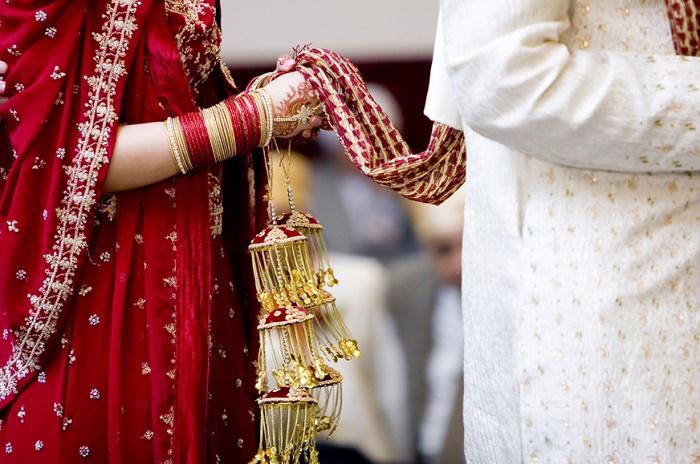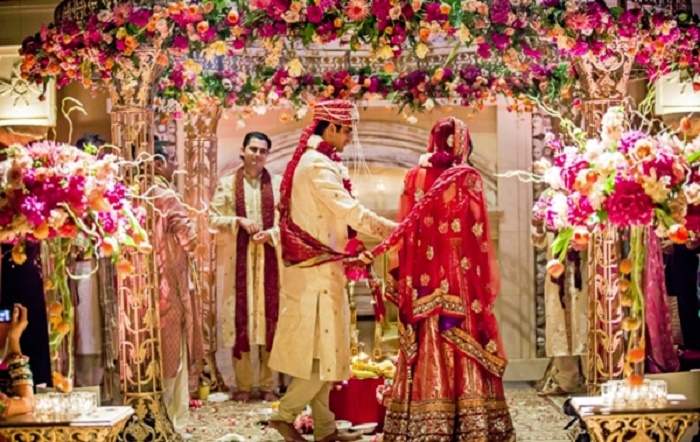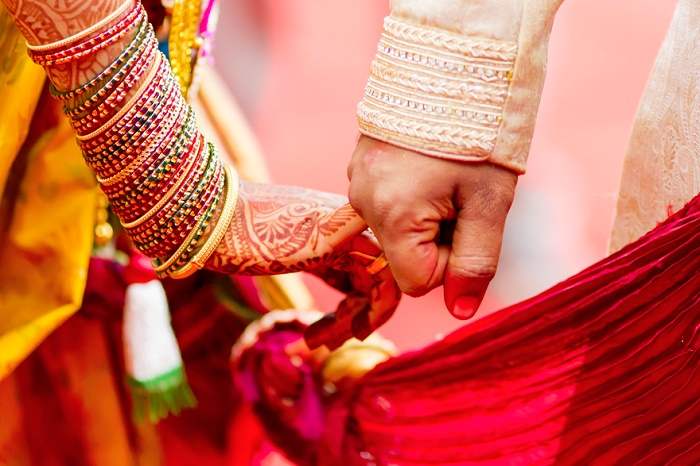
Image Credit: wetellyouhow.com/wp-content/uploads/2013/09/phere-1.jpg
Marriages are an important rite of passage in an individual’s life for any religion or culture. It marks one’s true entry into adulthood, marking him or her fit for taking on the responsibility of well-being of another human being. At the heart of every flashy, extravagant Indian wedding ceremony lies the austerely honest Vedic Hindu Wedding Rituals. The 13 intricate stages of the actual Hindu wedding ceremony enforce the seriousness of what a marriage entails through the various rituals and mantras. Every ritual has its own significance and cannot be done away with. All these ceremonial rituals revolves around the main one which is termed as the Saptapadi (literal meaning: Sapta-Seven and Padi-Steps) where the bride and the groom utter the seven vows of the wedding, hence the marriage, all the while revolving around the sacred fire, seven times.
Religious Background
According to Hindu beliefs, marriages are made in heaven and once the marriage is solemnized, the two souls are joined for seven lifetimes. The seven vows of marriage are the seven promises which the bride and the groom make to each other for a happy and prosperous life. They are bound together by an unseen bond protected by these promising words. Without exaggeration, the seven vows can be said to contain the crux of an ideal marriage that is to be practiced by the bride and groom.

The Ritual of Saath Pheras
The seven vows, known as Saptapadi, are performed along with Mangal pheras, which is walking around the sacred fire. Any Hindu marriage is incomplete without these vows and is deemed complete once they are conducted. On the day of the wedding the bride and the groom sit under the Mandap or the scared canopy for this ritual. The sacred fire is lighted along with the customary Home puja done by the priests. The corners of bride’s saree and the groom’s Uttariya are tied in a sacred knot by the priest. They are then asked to stand up and take the seven ‘Pheras’ or circumambulations around the sacred fire, all the while uttering a different promise with each Phera. The bride is seated towards left of the groom before the Pheras, while towards the right after they are complete. The Seven Vows along with the Seven Pheras are the most important ritual in a Hindu Wedding as it sanctifies the union and affords social recognition to the marriage. This is evident from the fact that when love marriages performed in temple, without a social gathering, marking the holy priest and the Almighty as the only witness, they only consist of seven vows or pheras around the fire.

The Seven Vows
The Seven Sacred Vows of marriage are described as follows:
For the First Vow, the Groom promises: “om esha ekapadi bhava iti prathaman” meaning ‘You will offer me food and be helpful in every way. I will cherish you and provide welfare and happiness for you and our children’. The bride complies in return:“dhanam dhanyam pade vadet”‘ I am responsible for the home and all household, food and finance responsibilities’. Concisely, the bride and groom promise each other prosperity by fulfilling their respective roles in their lives.
For the Second Vow the groom says: “om oorje jara dastayaha”, meaning ‘Together we will protect our house and children’. The Bride in return promises “kutumburn rakshayishyammi sa aravindharam”, which translates as ‘I will be by your side as your courage and strength. I will rejoice in your happiness. In return, you will love me solely’.
During the Third Vow, the Groom says, “om rayas santu joradastayaha” by which he means ‘May we grow wealthy and prosperous and strive for the education of our children and may our children live long.’ In return the Bride promises, “tava bhakti as vadedvachacha”, meaning ‘I will love you solely for the rest of my life, as you are my husband. Every other man in my life will be secondary. I vow to remain chaste’.
During the Fourth Vow, the Groom declares “om mayo bhavyas jaradastaya ha” by which he means ‘You have brought sacredness into my life, and have completed me. May we be blessed with noble and obedient children’ In return for this promise, the Bride says “lalayami cha pade vadet”, by which she means, ‘I will shower you with joy, from head to toe. I will strive to please you in every way I can’.
For the Fifth Vow, the Groom says, “om prajabhyaha santu jaradastayaha”, which means ‘You are my best friend, and staunchest well-wisher. You have come into my life, enriching it. God bless you’. To this the Bride says, “arte arba sapade vadet” or ‘I promise to love and cherish you for as long as I live. Your happiness is my happiness, and your sorrow is my sorrow. I will trust and honor you, and will strive to fulfill all your wishes’.
During the Sixth Vow, the Groom asks, “Rutubhyah shat padi bhava” which means ‘Now that you have taken six steps with me, you have filled my heart with immense happiness. Will you do the kindness of filling my heart with happiness like this for all times?’ to this the Bride replies, “yajna hom shashthe vacho vadet” meaning ‘I will always be by your side’.
For the Last and Seventh Vow, the Groom says “Om sakhi jaradastayahga”, by which he proclaims ‘We are now husband and wife, and are one. You are mine and I am yours for eternity.’ The Bride accepts this proclamation and says “Attramshe sakshino vadet pade”, which means ‘As God is witness, I am now your wife. We will love, honor and cherish each other forever.’
Significance
The marriage vows form the center of any Wedding ceremony. The words are uttered by the couple as an expression of their future intentions as well as promises they wish to uphold in their married life. The vows cover the generally accepted do’s and don’ts of a successful married life. So, they cover almost everything; from individual roles to the promise of putting each other’s happiness first. They promise to bear the responsibility of rearing a family together and do right by their children. The promise is to enter the union as equals, as friends rather than submitting to some age old defined roles. Not just for the Hindus, during a Vedic wedding ceremony, but in every other culture, wedding vows outline the same goals – lifelong commitment, devotion and mutual respect. Marriage is a bond that is everlasting and all these vows reinforce the couple’s intent to stay together through thick and thin of life, till death separate them part.




